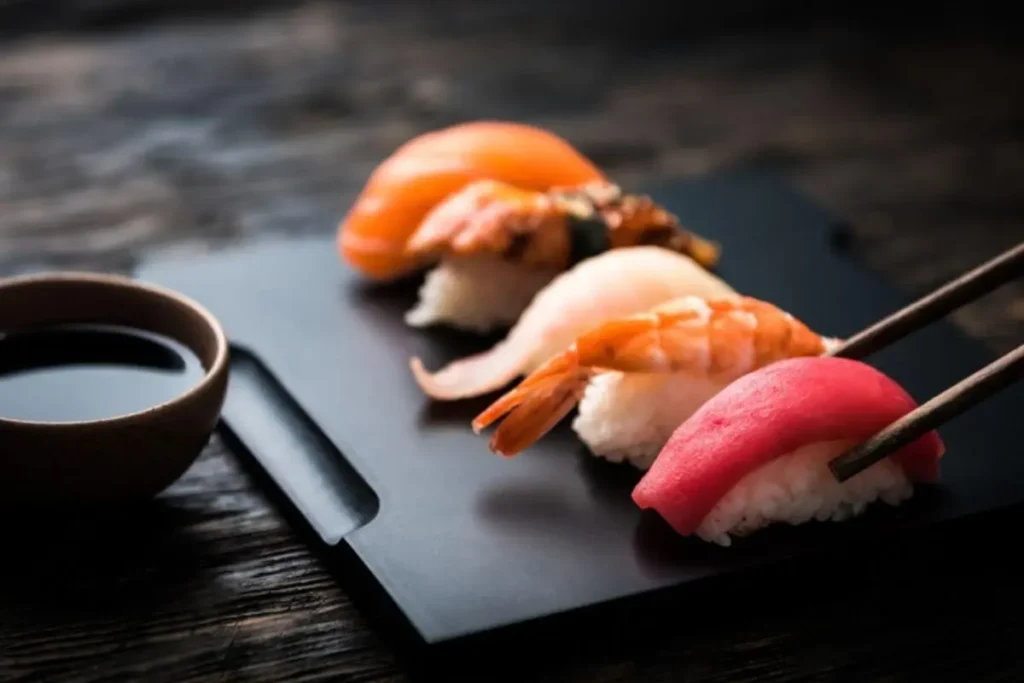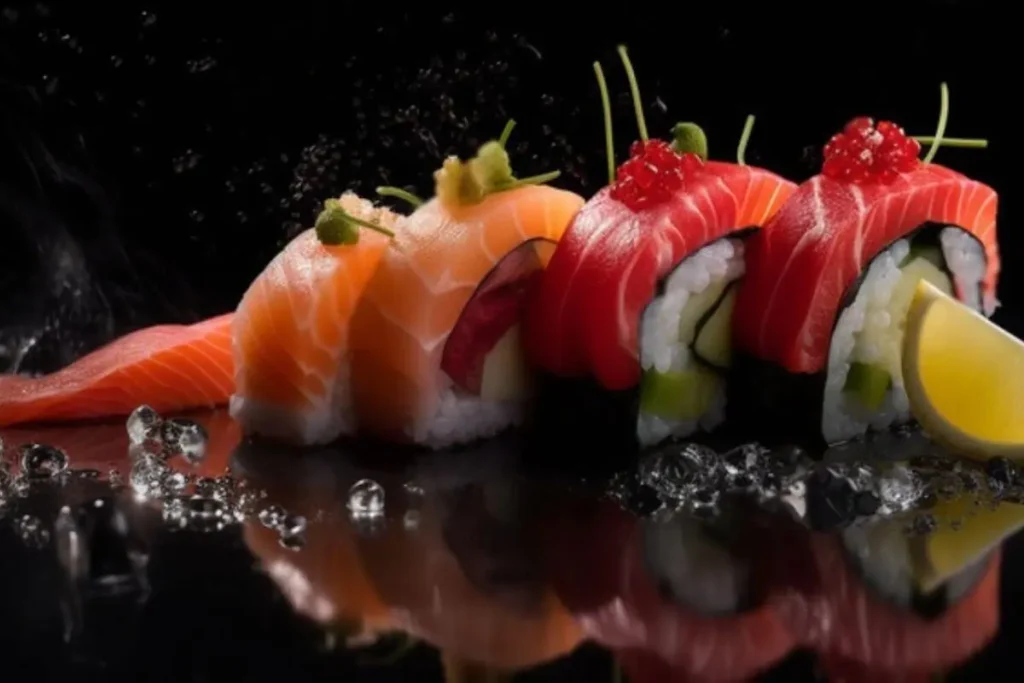Nigiri sushi is a popular type of sushi that features a simple yet delicious combination of fresh ingredients. It consists of a small mound of vinegared rice, topped with a slice of raw fish or seafood.
The rice is seasoned with a touch of wasabi, and sometimes a bit of soy sauce is added for extra flavor. Unlike other sushi varieties that involve rolling or layering ingredients, nigiri is known for its minimalist approach, emphasizing the quality and taste of each component.
This style of sushi highlights the art of balancing flavors and textures, making it a favorite choice for sushi enthusiasts around the world.
History and Origins of Nigiri Sushi:
Nigiri sushi has a fascinating history that dates back to the Edo period in Japan (1603–1868). It originated in Tokyo, then known as Edo, and was initially a form of fast food.
During this time, Tokyo was a bustling city with a growing population, and sushi shops sought to create a convenient and tasty option for people on the go.
The concept of nigiri sushi began as a type of “edomae-zushi” (Edo-style sushi). The term “nigiri” means “to grasp” in Japanese, referring to the way the sushi rice is molded by hand.
The original nigiri sushi was topped with a slice of fish that was lightly cured or preserved, which helped to enhance its flavor and preserve it before refrigeration was common.

Ingredients Used in Nigiri Sushi:
Nigiri sushi primarily features a few key ingredients:
- Sushi Rice (Shari): This is a special type of rice seasoned with a mixture of rice vinegar, sugar, and salt. It’s slightly sticky, allowing it to hold its shape when molded into small mounds.
- Raw Fish or Seafood: Commonly used toppings include slices of salmon, tuna, eel, shrimp, and other seafood. The fish is often served fresh and maybe lightly marinated or seasoned.
- Wasabi: A spicy green paste made from Japanese horseradish. It’s typically placed between the rice and the topping to add a bit of heat and enhance the overall flavor.
- Soy Sauce: This is used for dipping the nigiri sushi. It adds a salty, umami flavor that complements the fish and rice.
- Pickled Ginger (Gari): Served on the side, pickled ginger is used to cleanse the palate between different types of sushi.
- Optional Garnishes: Some variations might include a touch of sea salt, a slice of lemon, or other garnishes to enhance the flavor profile of the nigiri.
These ingredients come together to create a balanced and flavorful dish that highlights the freshness of the fish and the subtle seasoning of the rice.
Types of Nigiri Sushi:
Nigiri sushi comes in various types, each with its unique toppings and flavors. Here are some popular types:
- Maguro (Tuna) Nigiri: Features a slice of raw tuna on top of the rice. It’s a popular choice for its rich flavor and meaty texture.
- Salmon Nigiri: Topped with a slice of raw salmon. It’s known for its soft, buttery texture and mild taste.
- Ebi (Shrimp) Nigiri: Includes a cooked shrimp placed on the rice. It’s often served with a touch of sweet sauce.
- Unagi (Grilled Eel) Nigiri: This type uses grilled eel, which is usually glazed with a sweet soy-based sauce. The eel is cooked and has a rich, savory flavor.
- Hamachi (Yellowtail) Nigiri: Features a slice of yellowtail fish. It’s appreciated for its firm texture and slightly sweet taste.
- Ikura (Salmon Roe) Nigiri: Topped with bright orange salmon roe. The roe adds a burst of salty, briny flavor.
- Toro Nigiri: Made with fatty tuna, or “toro,” which is prized for its rich, buttery texture and flavor. It’s considered a delicacy in sushi.
- Hirame (Flounder) Nigiri: Includes a slice of flounder. It has a delicate taste and smooth texture.
- Aji (Horse Mackerel) Nigiri: Features a slice of horse mackerel, known for its stronger, more pronounced flavor.
- Tako (Octopus) Nigiri: Uses a slice of cooked octopus, which provides a chewy texture and mild flavor.
Each type of nigiri sushi highlights different fish or seafood, showcasing a range of textures and flavors while adhering to the classic presentation of sushi rice and topping.
Preparation and Technique:
Preparing nigiri sushi involves a few essential steps to ensure that each piece is perfectly crafted and delicious. Here’s a basic overview of the process:
- Prepare the Sushi Rice:
- Cook the Rice: Use short-grain or sushi rice and cook it according to the package instructions. It’s important to rinse the rice before cooking to remove excess starch.
- Season the Rice: While the rice is still warm, mix in a seasoned vinegar mixture made of rice vinegar, sugar, and salt. Gently fold the mixture into the rice to season it evenly. Allow the rice to cool to room temperature.
- Prepare the Toppings:
- Select Fresh Fish or Seafood: Choose high-quality, fresh fish or seafood for your nigiri. Common options include tuna, salmon, shrimp, eel, and others.
- Slice the Toppings: Cut the fish or seafood into thin, even slices, typically about 1/4 to 1/2 inch thick. The slices should be slightly larger than the rice mound they will sit on.
- Shape the Rice:
- Form the Rice Mounds: Wet your hands to prevent the rice from sticking. Take a small amount of sushi rice (about the size of a small egg) and gently mold it into a small, oval-shaped mound. The rice should be compact but not too pressed.
- Assemble the Nigiri:
- Add Wasabi (Optional): Place a small amount of wasabi on top of the rice mound. This is optional but adds a traditional kick of flavor.
- Place the Topping: Lay a slice of prepared fish or seafood over the rice mound. Gently press it into place to ensure it adheres to the rice.
- Finishing Touches:
- Garnish: If desired, add a small touch of soy sauce or a sprinkle of sea salt on top of the fish. Some varieties might include additional garnishes like a slice of lemon or a touch of green onions.
- Serve Immediately: Nigiri sushi is best enjoyed fresh, so serve it as soon as it’s assembled to maintain the ideal texture and flavor.
By carefully preparing the rice and toppings and using the right technique to shape and assemble the nigiri, you can create a classic sushi experience that highlights the quality and freshness of the ingredients.
Serving and Presentation:
Serving and presenting nigiri sushi is an art that emphasizes the dish’s simplicity and elegance. Here’s how to serve and present nigiri sushi effectively:
- Choose the Right Plate:
- Use a clean, flat plate or sushi mat to present nigiri sushi. Traditional options include wooden or ceramic plates, which enhance the visual appeal.
- Arrange the Nigiri:
- Neat Arrangement: Place the nigiri pieces in a single layer on the plate, neatly arranged. Avoid overcrowding to ensure each piece is easily accessible.
- Balanced Layout: Arrange the nigiri with some space between each piece. This allows for easy picking and prevents the pieces from sticking together.
- Add Condiments:
- Soy Sauce: Serve a small dish of soy sauce for dipping. You can also place the soy sauce dish on the side or directly on the plate if space allows.
- Pickled Ginger: Place a small portion of pickled ginger (gari) on the plate. It’s used to cleanse the palate between different types of nigiri.
- Wasabi: If wasabi was not included on the nigiri itself, you can offer a small dab on the side for guests to add as they like.
- Garnish Thoughtfully:
- Minimal Garnishes: Keep garnishes minimal to maintain the focus on the nigiri. A small garnish of fresh herbs, a slice of lemon, or a sprinkle of sea salt can be added if it complements the flavor of the fish.
- Presentation Tips:
- Freshness and Cleanliness: Ensure that the nigiri is fresh and the presentation area is clean. Freshness is crucial for both taste and visual appeal.
- Highlighting Quality: If using high-quality ingredients, let them be the focal point of the presentation. The simplicity of nigiri allows the natural beauty of the fish and rice to shine through.
- Serving Etiquette:
- Serve at Room Temperature: Nigiri sushi should be served at room temperature to enhance its flavor and texture.
- Use Proper Utensils: Provide chopsticks for eating, and offer small plates for individual servings if necessary.
By paying attention to these details, you ensure that the nigiri sushi is not only delicious but also visually appealing, making for an enjoyable and authentic dining experience.

Tips for Making Nigiri Sushi at Home:
Making nigiri sushi at home can be a rewarding experience if you follow these tips to ensure quality and authenticity:
- Use High-Quality Ingredients:
- Fresh Fish: Choose the freshest fish or seafood possible. Visit a reputable fish market or grocery store with a good selection of sushi-grade fish.
- Sushi Rice: Use short-grain or sushi rice for the right texture. Look for rice labeled specifically for sushi.
- Prepare Sushi Rice Properly:
- Cook Evenly: Follow the cooking instructions carefully to achieve the right texture. The rice should be slightly sticky but not mushy.
- Season Well: Mix the rice vinegar, sugar, and salt into the rice while it’s still warm. Let it cool to room temperature before using.
- Slice Fish Correctly:
- Uniform Cuts: Slice the fish against the grain into thin, even pieces. This ensures a tender texture and consistent appearance.
- Sharp Knife: Use a very sharp knife to make clean cuts. A dull knife can tear the fish and affect presentation.
- Shape the Rice Carefully:
- Wet Hands: Wet your hands with water to prevent the rice from sticking. This also helps in forming the rice mounds more easily.
- Form Gently: Mold the rice into small, oval-shaped mounds using a gentle, pressing motion. Avoid pressing too hard to keep the rice light and fluffy.
- Assemble the Nigiri:
- Add Wasabi (Optional): Place a small amount of wasabi on the rice before adding the fish if desired.
- Top with Fish: Lay a slice of fish over the rice mound and gently press to adhere. Ensure the fish covers the rice evenly.
- Serve Fresh:
- Immediate Serving: Nigiri sushi is best served immediately after preparation to ensure freshness and optimal texture.
- Keep It Cool: If you need to store it for a short period, keep it in the refrigerator, but bring it back to room temperature before serving.
- Practice Presentation:
- Neat Arrangement: Arrange the nigiri pieces neatly on a plate. Avoid overcrowding and maintain spacing between pieces.
- Add Condiments: Provide soy sauce, pickled ginger, and optional wasabi for dipping and palate cleansing.
- Clean and Sanitize:
- Work Area: Keep your work area clean and sanitized. Wash your hands and any utensils or surfaces that come into contact with raw fish.
By following these tips, you can create delicious and authentic nigiri sushi right at home, enjoying a restaurant-quality experience in your kitchen.
